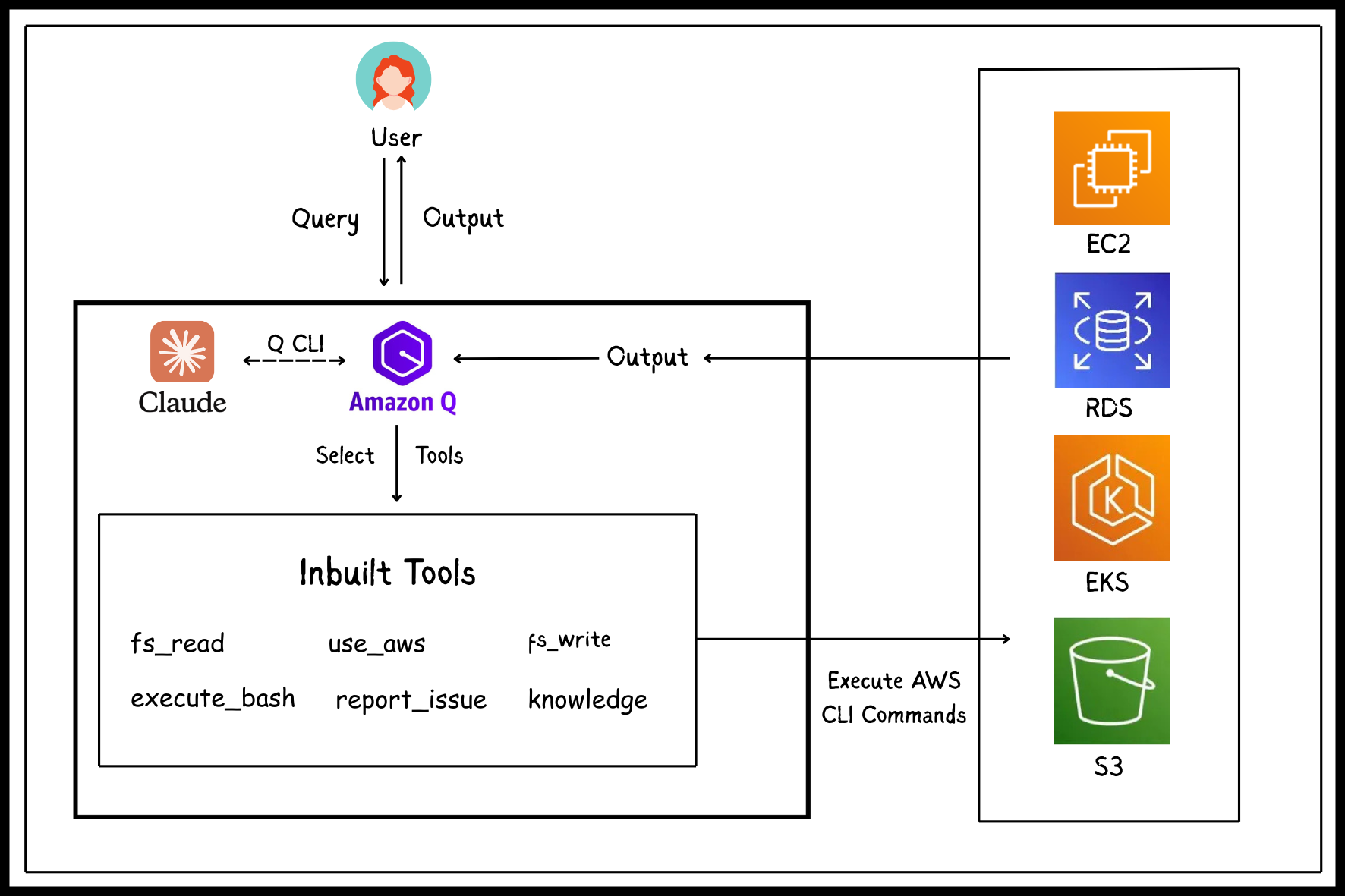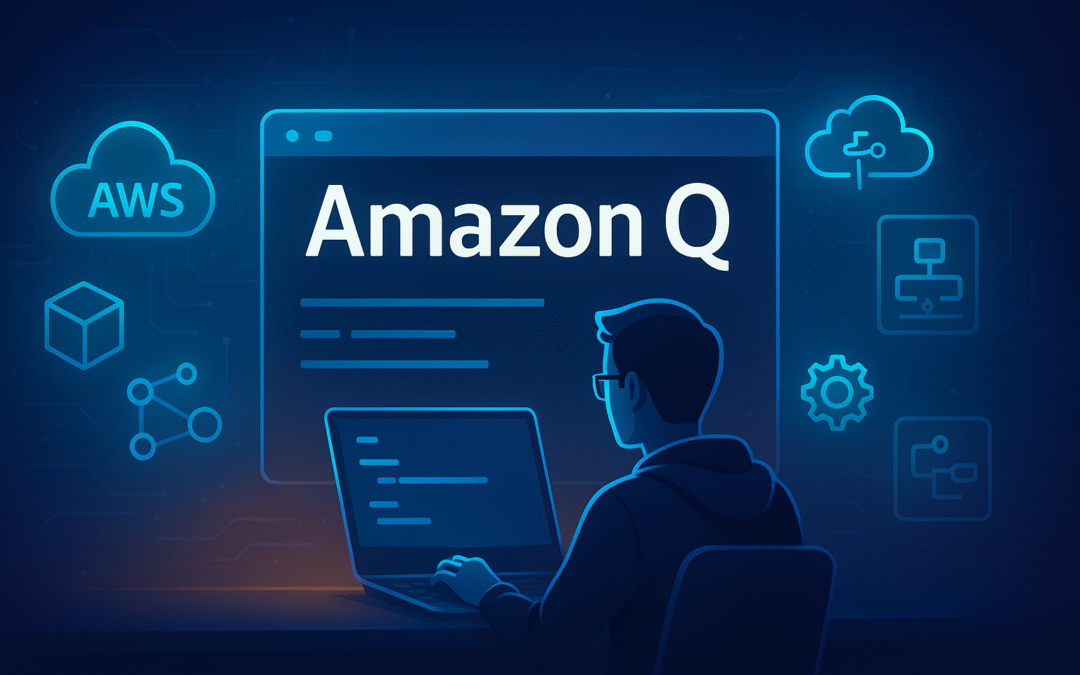Overview
The command line has long been the preferred workspace for developers.But remembering commands and complex syntax is a pain.
Amazon Q Developer CLI changes that.
Just talk to your terminal in plain English—it’ll debug, explain, or even write scripts for you.
No more memorizing syntax. Just get things done
What is Amazon Q Developer CLI ??
Amazon Q CLI is an AI powered command line interface .Powered by Claude 3.7 Sonnet, it acts as an intelligent coding companion that understands natural language, debugs issues, and even writes scripts on your behalf.
With Q CLI, you can query on the terminal in plain English, and the Q CLI will convert them into AWS CLI commands and execute them.
Whether you’re debugging a failed deployment, generating a complex
Makefile, or exploring AWS resources, Amazon Q CLI brings the power of generative AI directly to your fingertips—right where you work.
Let’s now examine the AWS Q CLI workflow. The diagram below shows how a user submits a query, it goes to AWS, and the user receives the results.
Here is how it works:

- When a user uses the Q CLI to query AWS (for example, to list the S3 buckets), the request is routed to a Claude model.
- Claude determines the appropriate AWS CLI command.
- Q CLI chooses the proper built-in tool to carry out the instructions to AWS.
- Results comes back and Claude now assists in transforming that into a clear, readable response as terminal output .
Installation Guide
Prerequisite
- macOS, Linux, or Windows (via WSL)
- An AWS Builder ID (free to create)
- Internet connection
Step 1: Install Amazon Q CLI
For macOS (using Homebrew):
brew install amazon-q
For Linux:
# Download the installer
curl -o install.sh https://aws.amazon.com/amazonq/cli/install
# Run the installer
bash install.sh
Step 2: Verify Installation
Check that Q CLI is properly installed:
q –version

Step 3: Authenticate with AWS Builder ID
After installation, authenticate using your AWS Builder ID:
q login

Clicking on the URL will open your browser for authentication. If you don’t have a Builder ID, you can create one for free during this process.

Click on Allow access to complete the authentication process.
Step 4: Start Your First Chat
Launch the interactive chat interface:
q chat

That’s it! You’re now ready to start using Amazon Q Developer CLI.
Amazon Q CLI Inbuilt Tools
Here are some inbuilt tools of the Q CLI:
- execute_bash:To run the Bash shell commands (such as ls, cat, and pwd)
- fs_read:Read the local file system, including directories and files.
- fs_write:Write or edit files on the local machine.
- use_aws:Uses the locally installed AWS CLI to interact with AWS services.
- report_issue:Report the issue to the Q like an error or bug in the Q CLI.
- knowledge:Provides information about Q CLI capabilities, features, commands, and documentation.
Querying AWS Resources With Amazon Q CLI Prompts
Let’s explore some practical scenarios where Amazon Q CLI shines.
List s3 Buckets
Let’s give a prompt for listing the available S3 buckets in the account.

Here,we can observe the use of tool use_aws where Q CLI converts our query to an AWS CLI command and executes it .The Q CLI then organises the raw data such that it appears as bullet points.
Generate GitHub Actions workflow
Let’s ask the chat to create a .github/workflows/ci.yaml that:
– runs on push to main
– checks out code
– builds docker image
– only deploys on success

Here Q Cli has used the tool fs_write that enables Q to create new files, update existing code, and generate project assets.
Create Terraform module to create EC2 Instance
Let’s provide a prompt to create a terraform module for creating EC2 instances.

Q CLI has created an entire project setup for provisioning EC2 instances using Terraform, including all the necessary files: main.tf, variables.tf, and output.tf.
What’s especially handy is that it automatically organises these files into a dedicated directory named ec2-module.
Now, you can use these ready-made files to deploy your resources—no need to spend time writing them from scratch
Conclusion
This blog introduces Amazon Q Developer CLI—an AI-powered terminal assistant that lets you use natural language to run commands, debug code, and write scripts—no memorization needed.
We cover how it reduces context-switching, simplifies the command line for everyone and speeds up your workflow. Plus, you can start using it today with the free tier—just set up your AWS Builder ID and install the CLI. Discover how Amazon Q Developer CLI makes your terminal smarter, faster, and more intuitive.

